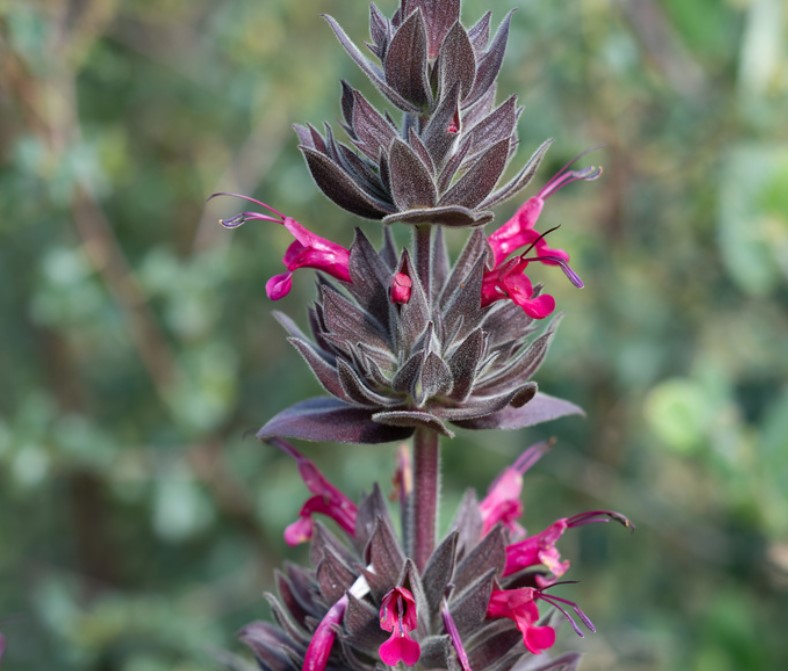Hummingbird Sage Plants Are Safe For Dogs & Cats and Not Poisonous
Are you a dog owner or lover like me and were you wondering “is hummingbird sage toxic to dogs?” I see this flowering plant all over the San Francisco Bay Area in Northern California when I am walking with my little dog, Lovie, and fortunately I can confirm that, no, Salvia spathacea aka “hummingbird safe” is not toxic to dogs, it is dog and cat safel

Physical Attributes of Salvia Spathacea aka “Hummingbird Safe”
| Attribute | Description |
|---|---|
| Plant Type | Semi-evergreen, spreading perennial herb[2][3] |
| Family | Lamiaceae (mint family)[3] |
| Height | 1-3 feet tall[2][3] |
| Spread | 3-5 feet wide[3] |
| Leaves | Bright green, arrow-shaped, scalloped, wrinkled, aromatic[3][4] |
| Flowers | Brilliant rose-pink to red, tubular, in pagoda-like whorls on upright stems[2][3][4] |
| Bloom Time | Spring through summer, with some blooms in fall[3][4] |
| Growth Habit | Spreading by rhizomes to form dense colonies[2][4] |
General Care Tips
- Grow in full sun to partial shade[2][3]
- Prefers well-drained soil, tolerates variety of soil types[2][3]
- Drought tolerant once established, but looks best with occasional summer water[2][4]
- Low maintenance, easy care plant[3]
- Cold hardy to around 0°F[-3]
- Can be pruned/deadheaded after blooming to promote new growth[4]
- Space plants 4-5 feet apart when planting[3]
Fun Facts
- Native to California and the only red-flowered native sage species[4]
- Aptly named for attracting hummingbirds and other pollinators[2][3][4]
- Has a pleasant fruity/pineapple-like aroma[4]
- Edible flowers can be used to make hummingbird sage shortbread or tea[4]
- Naturally occurs under oaks and large shrubs in chaparral and woodlands[2]
- Forms a good groundcover and is deer resistant[2][3]
- The genus name Salvia comes from the Latin word salvare meaning “to heal”[4]
We check the flowers we feature on our site with the ASPCA website list of nontoxic versus toxic plants and do extensive internet research for both the common and scientific name just to be super pet safe. If we cannot find direct reference, we check up to genus and so on until we can confirm whether a plant is toxic or non toxic to either cats or dogs. If we are not sure, or get contradictory information, we do not include it. Many of the plants featured we have grown successfully in our own pet safe garden in Northern California. You can see many of garden stars in photos from Lovie’s Pet Safe Garden. Sage/ Salvia is one of our favorite categories of aromatic, often flowering plants that are safe for dogs, cats and horses. We love it and so do hummingbirds and if you decide to plant it in your pet safe garden, you will understand why as you grow to love it too.
| Consideration | Details |
|---|---|
| Container Friendly | Yes, can be grown in containers.[1][4] |
| Indoor/Outdoor | Outdoor plant only.[1][2][3][4][5] |
| Sun/Shade | Prefers partial shade to full shade, tolerates full sun.[2][3][4][5] |
| Perennial/Annual | Perennial, semi-evergreen herb.[2][3][4][5] |
| Flowering | Brilliant rose-pink to red tubular flowers bloom in spring through summer.[3][4][5] |
| Drought Tolerant | Yes, drought tolerant once established.[2][3][4][5] |
| Pollinator Magnet | Yes, attracts hummingbirds, bees, and butterflies.[1][2][3][4][5] |
| Beginner Friendly | Yes, easy to grow and low maintenance.[2][3][4] |
| Good Ground Cover | Yes, spreads by rhizomes to form a dense groundcover.[1][3][4][5] |
| Good Privacy Screen | No, grows only 1-3 feet tall.[2][3][4][5] |
| Invasive/Spreader | Can spread vigorously by rhizomes but not considered invasive.[3][4] |
| Hardy/Delicate | Hardy perennial, cold tolerant to around 0°F.[2][3][4] |
| Rodent Repellent | No specific evidence of rodent repelling ability.[1][2][3][4][5] |
| Deer Resistant | Yes, deer resistant due to aromatic foliage.[2][3][5] |
| Native To | Native to California.[1][3][4][5] |
| Ideal States/Regions | Hardy in USDA zones 8-11. Grows well in coastal CA and other mild winter areas.[2][3][4][5] |
Citations:
[1] https://waterwisegardenplanner.org/plants/salvia-spathacea/
[2] https://www.gardeningknowhow.com/ornamental/flowers/salvia/growing-hummingbird-sage-plants.htm
[3] https://www.homegroundhabitats.org/product/salvia-spathacea-red-hummingbird-sage/
[4] https://calscape.org/Salvia-spathacea-%28Hummingbird-Sage%29
[5] https://www.gardenia.net/plant/salvia-spathacea
[6] https://herbarium.menloschool.org/hummingbird-sage
[7] https://calscape.org/Salvia-spathacea-%28Hummingbird-Sage%29
[8] https://www.gardenia.net/plant/salvia-spathacea
[9] https://granadanativegarden.org/2018/03/27/hummingbird-sage-a-different-kind-of-sage/
[10] https://en.wikipedia.org/wiki/Hummingbird
The photo above is from iNaturalist. Thank you to the photographer for posting, sharing, and making it available so that pet owners can have a visual.





